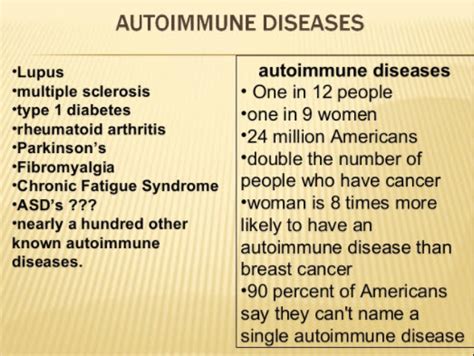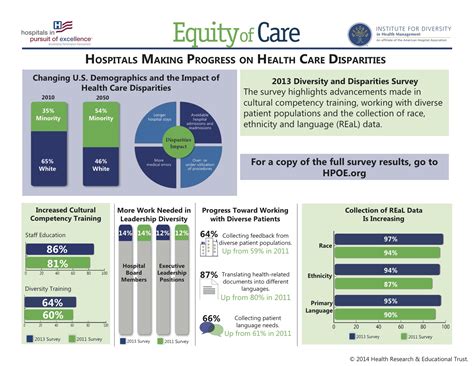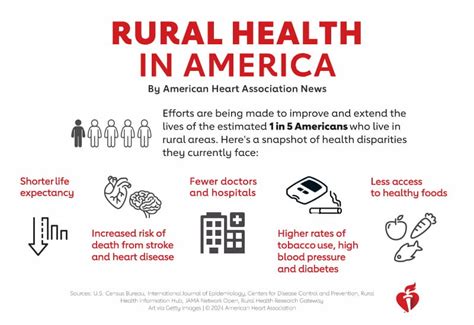Health Disparities In Autoimmune Disease

Autoimmune diseases, which affect an estimated 50 million Americans, are a group of conditions where the immune system mistakenly attacks the body's own tissues, resulting in a wide range of chronic and often debilitating health issues. Despite the prevalence and severity of autoimmune diseases, significant health disparities exist, affecting certain populations disproportionately. These disparities are rooted in a complex interplay of genetic, environmental, and socio-economic factors, which not only impact the likelihood of developing an autoimmune disease but also influence the quality of care and health outcomes for affected individuals.
The burden of autoimmune diseases is not evenly distributed across different racial, ethnic, and socio-economic groups. For instance, lupus, a chronic autoimmune disease that can affect multiple organs, is more prevalent among African American women than among white women, with a reported incidence rate of 1.6 per 1,000 person-years compared to 0.5 per 1,000 person-years, respectively. Similarly, type 1 diabetes, an autoimmune condition characterized by the immune system's destruction of insulin-producing beta cells, is more common among non-Hispanic white children than among children from other racial or ethnic backgrounds. These disparities underscore the need for a nuanced understanding of the factors contributing to the development and progression of autoimmune diseases in diverse populations.
Causes and Contributing Factors of Health Disparities in Autoimmune Disease

The causes of health disparities in autoimmune diseases are multifaceted and include genetic predisposition, environmental triggers, and socio-economic factors such as access to healthcare, education, and economic status. For example, genetic susceptibility plays a significant role in the development of autoimmune diseases, with certain genetic variants conferring a higher risk of disease. However, the expression of these genetic predispositions can be influenced by environmental factors, such as exposure to ultraviolet radiation, which has been shown to increase the risk of developing vitiligo, an autoimmune disease characterized by the loss of skin pigment.
Socio-economic factors also contribute significantly to health disparities in autoimmune diseases. Individuals from lower socio-economic backgrounds may face barriers to accessing healthcare, including lack of health insurance, higher costs of care, and limited access to specialist providers. These barriers can result in delayed diagnosis, inadequate treatment, and poorer health outcomes. For instance, a study found that patients with rheumatoid arthritis who had lower incomes and less education were more likely to experience delays in diagnosis and initiation of treatment, leading to worse disease outcomes.
Impact of Environmental Factors on Autoimmune Disease Disparities
Environmental factors, such as exposure to air pollution, pesticides, and heavy metals, have been implicated in the development and exacerbation of autoimmune diseases. These factors can trigger or worsen autoimmune responses, particularly in individuals with genetic predispositions. For example, exposure to particulate matter has been linked to increased inflammation and immune system activation, which can contribute to the development of autoimmune diseases such as multiple sclerosis. Moreover, environmental factors can disproportionately affect certain populations, such as low-income communities or communities of color, which may be more likely to live in areas with high levels of pollution.
| Autoimmune Disease | Prevalence Rate | Disparities |
|---|---|---|
| Lupus | 1.6 per 1,000 person-years (African American women) | Racial/ethnic disparities in incidence and mortality |
| Type 1 Diabetes | 1.4 per 1,000 person-years (non-Hispanic white children) | Racial/ethnic disparities in incidence and complications |
| Rheumatoid Arthritis | 0.8 per 1,000 person-years (adults) | Socio-economic disparities in access to care and health outcomes |

Key Points
- Autoimmune diseases affect approximately 50 million Americans, with significant health disparities across different racial, ethnic, and socio-economic groups.
- Genetic predisposition, environmental triggers, and socio-economic factors contribute to the development and progression of autoimmune diseases.
- Environmental factors, such as exposure to air pollution and pesticides, can trigger or worsen autoimmune responses, particularly in individuals with genetic predispositions.
- Socio-economic disparities in access to healthcare and health education can result in delayed diagnosis, inadequate treatment, and poorer health outcomes.
- A comprehensive approach addressing genetic, environmental, and socio-economic factors is necessary to reduce health disparities in autoimmune diseases.
Addressing Health Disparities in Autoimmune Disease: A Multifaceted Approach

Addressing health disparities in autoimmune diseases requires a multifaceted approach that incorporates genetic, environmental, and socio-economic considerations. Increasing access to healthcare, promoting health education, and reducing environmental exposures are critical steps in reducing disparities. Moreover, community-based initiatives and patient-centered care models can help address the unique needs of diverse populations and improve health outcomes.
Research initiatives focused on understanding the genetic and environmental factors contributing to autoimmune diseases in diverse populations are also essential. These initiatives can inform the development of targeted interventions and treatments that address the specific needs of underserved communities. Furthermore, policy changes aimed at reducing environmental exposures and promoting healthcare access can have a significant impact on reducing health disparities in autoimmune diseases.
Future Directions: Personalized Medicine and Precision Health
The future of addressing health disparities in autoimmune diseases lies in the development of personalized medicine and precision health approaches. These approaches involve tailoring treatments and interventions to an individual's unique genetic, environmental, and socio-economic profile. By leveraging advances in genomics, epigenomics, and environmental health sciences, healthcare providers can develop targeted strategies to prevent, diagnose, and treat autoimmune diseases in diverse populations.
What are the main causes of health disparities in autoimmune diseases?
+The main causes of health disparities in autoimmune diseases include genetic predisposition, environmental triggers, and socio-economic factors such as access to healthcare, education, and economic status.
How can healthcare providers address health disparities in autoimmune diseases?
+Healthcare providers can address health disparities in autoimmune diseases by increasing access to healthcare, promoting health education, and reducing environmental exposures. Community-based initiatives and patient-centered care models can also help address the unique needs of diverse populations.
What is the role of research in addressing health disparities in autoimmune diseases?
+Research plays a critical role in addressing health disparities in autoimmune diseases by informing the development of targeted interventions and treatments that address the specific needs of underserved communities. Research initiatives focused on understanding the genetic and environmental factors contributing to autoimmune diseases in diverse populations are essential.
Meta Description: Health disparities in autoimmune diseases affect diverse populations, with genetic, environmental, and socio-economic factors contributing to disparities. A comprehensive approach addressing these factors is necessary to reduce disparities and improve health outcomes.



